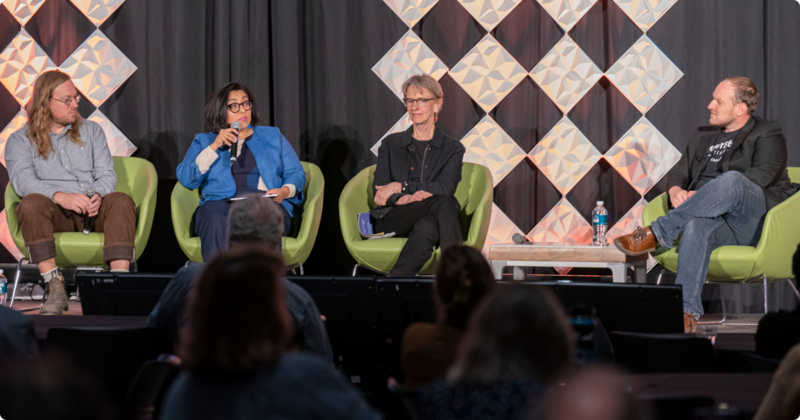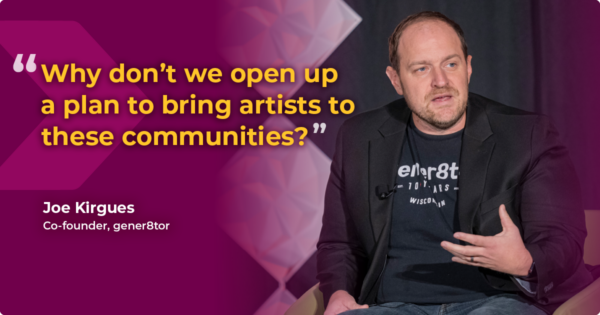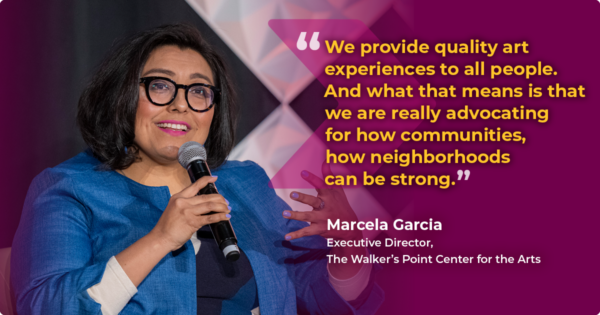
“Beyond Boundaries: Creatives As Economic Change Agents,” a panel at the Wisconsin Economic Summit 2024, featured (from L to R) John Riepenhoff, Marcela Garcia, Donna Neuwirth, and Joe Kirgues.
The arts play a crucial role in economic development, with investments yielding indirect and sometimes direct dividends—and Wisconsin would be wise to make more of these investments, speakers on a panel at the Wisconsin Economic Summit 2024 told the audience.
“Genius likes being around other genius,” and a thriving arts community will help attract brilliant residents across all sectors, said moderator Joe Kirgues, co-founder of gener8tor, the Madison-based business accelerator.
The panelists suggested that Wisconsin needs a better strategy to connect artists to economic development and investment opportunities to become a driver of a vibrant and competitive state economy. A Wisconsin Public Radio report earlier this year noted that Wisconsin invests 18 cents on a per-capita basis in the creative economy, compared to $5.15 in Illinois and $9.67 in Minnesota.
Kirgues said his group has partnered with colleges and universities and the Global Entrepreneur in Residence program to attract businesses to come and build their businesses here. “I’ve been looking at it and thinking: Why don’t we do that in the arts?” said Kirgues, whose organization supports 435 startups in 85 accelerators nationally. “Why don’t we open up a plan to bring artists to these communities?”
 Panelist John Riepenhoff is an internationally known artist and executive director at Sculpture Milwaukee. He also runs the Beer Endowment that helps breweries design beers, recipes, and branding, which helps raise money for arts groups.
Panelist John Riepenhoff is an internationally known artist and executive director at Sculpture Milwaukee. He also runs the Beer Endowment that helps breweries design beers, recipes, and branding, which helps raise money for arts groups.
“We know that art is a contributor to the economy,” Riepenhoff said. “The next chapter is going to be about articulating that value to the businesses of Wisconsin.”
Donna Neuwirth is executive director of the Wormfarm Institute, which runs Farm/Art Dtour, an art installation involving a 50-mile self-guided drive through scenic working farmlands in Sauk County.
“This is the time for us to cooperate on a place we want to live. And, ultimately, that’s what economic development is,” she said. “I think we have a lot going for us here. The fact that we’re 49th or 50th in terms of art funding is a big setback. But it’s made us really scrappy and strong.”
 Marcela Garcia, an artist and executive director of the Walker’s Point Center for the Arts in Milwaukee, said her organization brings art to all segments of the community. That is an investment that pays dividends, Garcia said.
Marcela Garcia, an artist and executive director of the Walker’s Point Center for the Arts in Milwaukee, said her organization brings art to all segments of the community. That is an investment that pays dividends, Garcia said.
“We provide quality art experiences to all people. And what that means is that we are really advocating for how communities, how neighborhoods can be strong,” she said, noting that the center serves 5,000 youths each year and makes art accessible to Milwaukee’s Latinx community with bilingual programming.
She said statistics show that creative enterprises contribute $933 million annually to Wisconsin’s economy and that arts and culture contribute 4.3% of the nation’s gross domestic product. “There’s a very close relationship between how art is leveraged as a way to build communities and activate economies,” she said.
Riepenhoff said a better statewide strategy is needed to fully realize the economic development potential of the state’s art community.
“There is not a good access point right now between artists and business leaders,” he told summit participants. “We need to understand what you see in the value of art; we need to articulate what we see and where we can help each other.”
